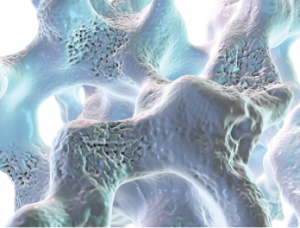
Kateryna Kon / shutterstock.com
It has long been known that hyperlipidemia adversely affects bone, but the exact pathologic mechanism(s) underlying hyperlipidemia-induced bone loss has not been fully understood. Until now.
Pathogenesis of Osteoporosis
New research by Ambrogini and colleagues shows that oxidation-specific epitopes derived from lipid peroxidation contribute to the pathogenesis of osteoporosis.1 Importantly, the research shows that innate immune antibodies against these epitopes can offer a protective effect against the disease—at least in mice.
“There are antibodies against oxidized phospholipids that are protective against osteoporosis,” says lead author of the study, Elena Ambrogini, MD, PhD, assistant professor, Division of Endocrinology and Metabolism, Center for Osteoporosis and Metabolic Bone Diseases, University of Arkansas for Medical Sciences and Central Arkansas Veterans HealthCare System, directed by Stavros C. Manolagas, MD, PhD, in Little Rock, Ark. “We have shown in mice that if you overexpress these antibodies, the mice have more bone.”
“This is the first proof-of-principle that oxidation-specific epitopes are involved in bone metabolism,” she says.
Pathogenesis of Atherosclerosis

Dr. Ambrogini
The study by Ambrogini et al. comes on the heels of another recently published study by Que et al. that demonstrates for the first time what has long been recognized without demonstrable proof—oxidized phospholipids contribute to the pathogenesis of atherosclerosis.2 Although it has long been suspected that oxidized phospholipids and oxidized low-density lipoprotein are involved in the pathogenesis of atherosclerosis, the study by Que et al. was the first to demonstrate this in vivo in murine models, according to senior author of the study, Joseph Witztum, MD, professor of medicine, Division of Endocrinology and Metabolism, University of California, San Diego.
Dr. Witztum, who is also a co-investigator in the osteoporosis study, emphasizes the implication of these results for humans. “We believe this is relevant to humans [because] oxidized phospholipids can be demonstrated to be abundant in almost all atherosclerotic lesions in humans,” he says.
As for osteoporosis, Dr. Witztum says further research is needed to determine the relevance to humans of the finding that oxidized phospholipids contribute to this disease as well.
If such research pans out, the hope is that one day a new therapeutic agent will be able to simultaneously target both osteoporosis and atherosclerosis.
‘This is the first proof-of-principle that oxidation-specific epitopes are involved in bone metabolism.’ —Dr. Ambrogini
Common Pathogenesis/Common Treatment
Epidemiological data have shown that osteoporosis, atherosclerosis and a high fat diet are linked. The new research demonstrates for the first time, in vivo in murine models, that oxidation-specific epitopes are an important common pathogenic factor that may underlie these links. In specific, the research shows that oxidized phospholipids impair the function of osteoblasts, the cells that build new bone.
For atherosclerosis, the potential involvement of these oxidation-specific epitopes has long been recognized, says Dr. Witztum. What is truly novel, he emphasizes, is demonstrating this same pathogenic mechanism underlies osteoporosis.
Ambrogini et al. discovered the common mechanisms underlying osteoporosis by examining the role of oxidation-specific epitopes in bone homeostasis in murine models. Using mice overexpressing antibodies that block the effects of oxidation-specific epitopes, the investigators found they could attenuate the high-fat-diet-induced loss of bone mass in these mice.
Importantly, the study also found that one of those antibodies increases bone mass not only in mice fed a high-fat diet, but also in mice fed a normal diet.

Dr. Witztum
According to Dr. Witztum, this strongly implies “that even under physiological conditions, oxidized phospholipids impair bone anabolism.” As such, he emphasized the need to better understand where the oxidation-specific epitopes are coming from. “This remains to be determined, but we have shown that as cells undergo apoptosis there is generation of oxidized phospholipids and that oxidized phospholipids are frequently present on vesicles released from cells, so in a period of rapid growth and bone turnover early in life one might speculate that this could be a source,” he says.
Given the attenuation of bone loss in the mice overexpressing the antibodies that block the oxidation-specific epitopes, the study does suggest these epitopes as a new potential therapeutic target for osteoporosis.
“It is known that these antibodies are already protective against cardiovascular disease in humans,” says Dr. Ambrogini. “Now we have to look at whether this is true for osteoporosis.”
Emphasizing that the study by Ambrogini and colleagues showed antibodies targeting oxidized phospholipids ameliorated their adverse effects on bone, Dr. Witztum says further study is needed to fully understand the pathogenetic mechanisms of these oxidation-specific epitopes. “Importantly, it remains to be determined if treatment to neutralize oxidized phospholipids after the diseases have been established will lead to prevention of advancement or even regression,” he says.
Mary Beth Nierengarten is a freelance medical journalist based in Minneapolis.
References
- Ambrogini E, Que X, Wang S, et al. Oxidation-specific epitopes restrain bone formation. Nat Commun. 2018 Jun 6;9(1):2193.
- Que X, Hung MY, Yeang C, et al. Oxidized phospholipids are proinflammatory and proatherogenic in hypercholesterolaemic mice. Nature. 2018 Jun; 558(7709):301–306.